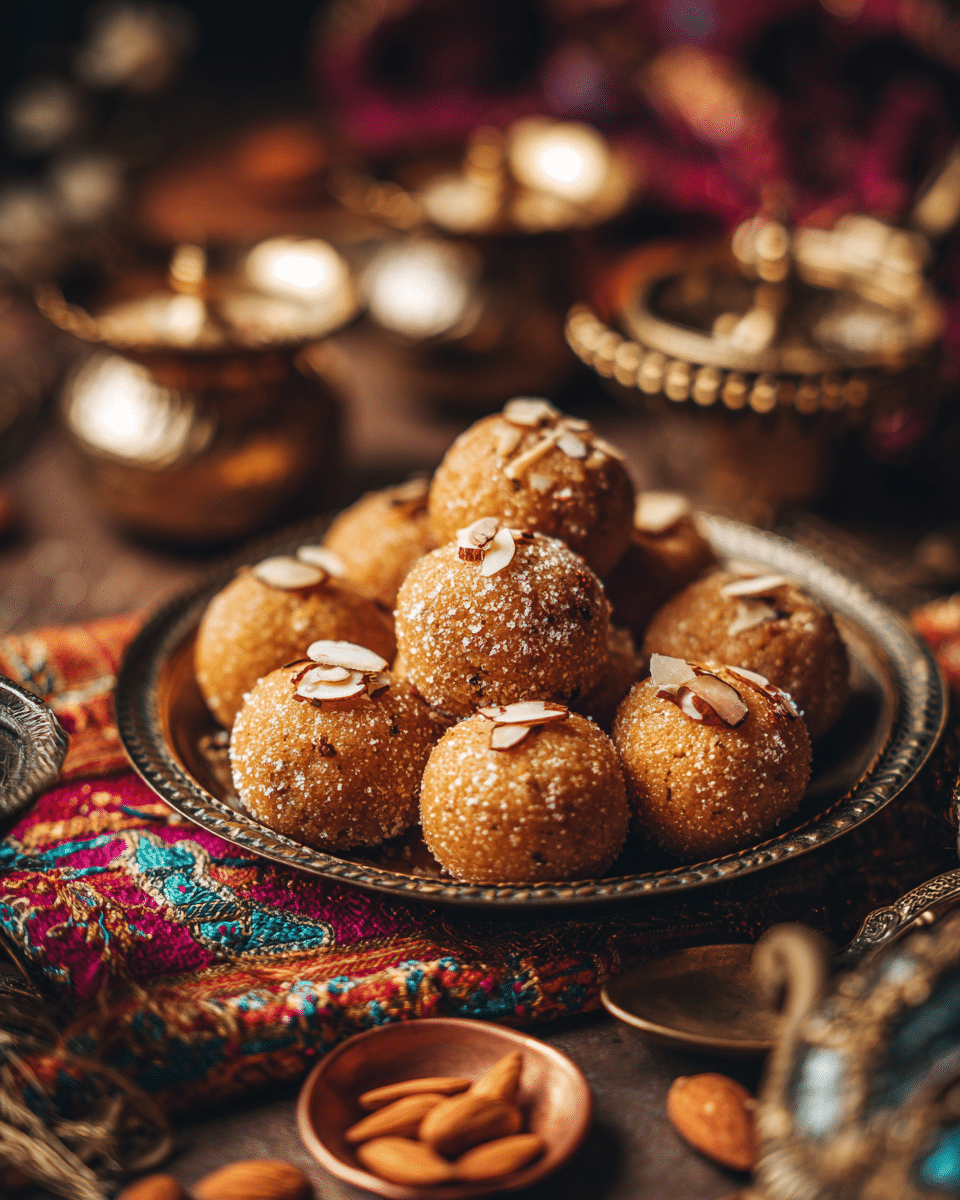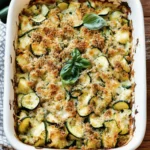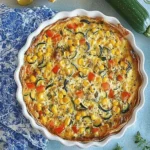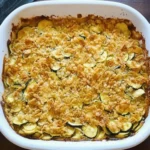Besan Ladoo Bites are a classic Indian sweet known for their rich, nutty flavor and soft, melt-in-your-mouth texture. Made from roasted gram flour (besan), ghee, and sugar, these mini ladoos are often enhanced with cardamom and chopped nuts, offering a fragrant aroma and delightful crunch. These bite-sized treats are perfect for festivals like Diwali or Raksha Bandhan, or simply as a homemade sweet to enjoy with a cup of chai.
FULL RECIPE
Ingredients
- 1 cup besan (gram flour)
- 1/4 cup ghee (clarified butter)
- 1/3 cup powdered sugar
- 1/4 teaspoon cardamom powder
- 2 tablespoons chopped cashews
- 2 tablespoons chopped almonds
- 1 tablespoon raisins (optional)
- A pinch of salt
Directions
- Heat a heavy-bottomed pan on low heat and add the ghee.
- Once the ghee melts, add the besan and stir continuously to avoid lumps.
- Roast the besan in ghee on low flame for about 10–12 minutes or until it turns golden brown and gives off a nutty aroma.
- Turn off the heat and allow the mixture to cool for 8–10 minutes until it is warm but not hot.
- Add the powdered sugar, cardamom powder, and a pinch of salt. Mix well to combine everything uniformly.
- Stir in the chopped cashews, almonds, and raisins (if using).
- Take small portions of the mixture and shape them into bite-sized balls using your hands. If the mixture feels too dry, add a teaspoon of warm ghee.
- Let the ladoos cool completely and store them in an airtight container.
Nutrition Facts
- Calories: 110
- Total Fat: 7g
- Saturated Fat: 3.5g
- Cholesterol: 12mg
- Sodium: 15mg
- Total Carbohydrates: 9g
- Dietary Fiber: 1g
- Sugars: 4g
- Protein: 2g
- Vitamin A: 1% DV
- Calcium: 1% DV
- Iron: 3% DV
History and Cultural Significance of Besan Ladoo
Besan Ladoo has a rich heritage rooted deeply in Indian culinary traditions. This sweet has been a staple in Indian households for centuries, especially during festivals and special occasions. Its origins trace back to ancient India, where gram flour was a common ingredient used in both savory and sweet dishes. The ladoos are more than just a dessert; they symbolize celebration, prosperity, and the joy of sharing. During festivals like Diwali and Raksha Bandhan, besan ladoos are often prepared and exchanged among family and friends, strengthening social bonds.
Nutritional Benefits of Besan
Besan, or gram flour, is the primary ingredient in these ladoos and offers significant nutritional benefits. It is a rich source of protein, making it an excellent option for vegetarians seeking plant-based protein. Besan also contains essential vitamins and minerals such as iron, magnesium, and B vitamins. Its low glycemic index means it releases energy slowly, helping maintain stable blood sugar levels. Additionally, besan is gluten-free, making besan ladoos a suitable treat for those with gluten sensitivities or celiac disease.
The Role of Ghee in Flavor and Texture
Ghee, or clarified butter, plays a vital role in the flavor profile and texture of besan ladoos. Its nutty aroma and rich mouthfeel elevate the simple ingredients, providing depth and warmth. Ghee also acts as a binding agent that helps the ladoos hold their shape while keeping them moist and soft. Beyond taste, ghee is rich in fat-soluble vitamins like A, D, E, and K, which contribute to health benefits when consumed in moderation. Its presence in traditional Indian sweets also adds a touch of authenticity.
Importance of Roasting Besan Properly
The roasting process of besan is crucial in developing the perfect flavor and texture of ladoos. Raw gram flour has a distinct earthy taste that can be bitter if not roasted well. Proper roasting until the besan turns golden brown and releases a nutty aroma neutralizes this bitterness and imparts a deep, rich flavor. The texture also improves as the flour becomes dry enough to bind with ghee and sugar without being grainy. Continuous stirring during roasting prevents burning and ensures even cooking.
Variations of Besan Ladoo
While the classic recipe remains beloved, besan ladoos come with numerous regional and personal variations. Some add nuts like pistachios or walnuts instead of the traditional cashews and almonds. Others incorporate dried fruits such as chopped dates or figs for added sweetness and texture. A few recipes include saffron strands or rose water to give a floral aroma. In some households, jaggery replaces powdered sugar to create a healthier, more rustic flavor profile. These variations allow flexibility to suit dietary preferences and taste.
Serving Suggestions and Pairings
Besan ladoos are incredibly versatile and can be enjoyed in various ways. They make a perfect festive dessert served after a traditional Indian meal. These sweets also pair wonderfully with beverages like masala chai or warm milk infused with cardamom, balancing the rich sweetness with spice and creaminess. For a modern twist, they can be crumbled over yogurt or ice cream for texture and flavor contrast. Serving ladoos slightly warm enhances their softness and flavor, making them even more delightful.
Storage Tips to Maintain Freshness
Proper storage of besan ladoos is essential to keep them fresh, moist, and flavorful. Since they contain ghee and nuts, ladoos should be stored in an airtight container at room temperature if consumed within a week. For longer storage, refrigeration is recommended, especially in warmer climates. When refrigerated, it is best to bring them to room temperature before serving to soften the texture. Freezing is possible but not ideal, as it may affect the ladoos’ texture upon thawing. Always use a dry spoon to avoid moisture contamination.
Health Considerations and Moderation
Although besan ladoos offer nutritional benefits, they are still a rich sweet treat and should be consumed in moderation. They are calorie-dense due to the combination of ghee and sugar, which can add up quickly if eaten in excess. Individuals managing weight, blood sugar, or cholesterol levels should be mindful of portion sizes. Using alternatives like jaggery or less sugar can make the ladoos healthier, and using ghee in controlled quantities can reduce fat content while retaining flavor. Enjoying besan ladoos as an occasional treat fits best within a balanced diet.
Festivals and Occasions Featuring Besan Ladoo
Besan ladoos are synonymous with Indian festivals and religious ceremonies. During Diwali, the festival of lights, these sweets are prepared in large batches as offerings to deities and shared with loved ones. They also feature prominently in Raksha Bandhan celebrations, symbolizing the sweet bond between siblings. Beyond these, besan ladoos are often part of wedding festivities, baby showers, and other auspicious occasions, underscoring their cultural and emotional significance. Their ease of preparation and shelf life make them a favorite festive gift.
Tips for Perfecting Your Besan Ladoo
Achieving the perfect besan ladoo requires attention to a few key details. First, roasting the besan on low heat and stirring constantly ensures even cooking and prevents burning. Next, letting the roasted flour cool slightly before adding sugar prevents the sugar from melting and makes mixing easier. Using finely powdered sugar is recommended for smooth texture. Adjusting ghee quantity can help achieve the right consistency for shaping ladoos—too dry and they crumble, too wet and they won’t hold shape. Lastly, rolling the ladoos while the mixture is warm ensures they bind well and form smooth balls.
Conclusion
Besan Ladoo Bites are a timeless Indian sweet that perfectly balances flavor, texture, and tradition. Their nutty aroma, enriched by roasted gram flour and ghee, along with subtle cardamom and crunchy nuts, creates a delightful treat loved across generations. Beyond taste, besan ladoos hold cultural significance and offer nutritional benefits when enjoyed mindfully. Whether for festivals, celebrations, or everyday indulgence, these ladoos remain a cherished recipe. With simple ingredients and careful preparation, anyone can bring the warmth of Indian tradition to their kitchen with these melt-in-the-mouth sweets.





